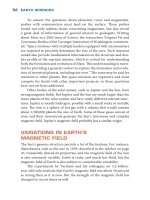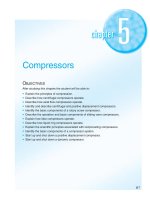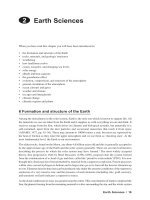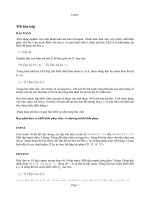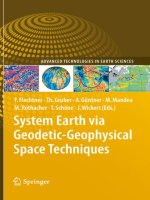- Trang chủ >>
- Khoa Học Tự Nhiên >>
- Vật lý
5 6 how weather works (earth sciences)
Bạn đang xem bản rút gọn của tài liệu. Xem và tải ngay bản đầy đủ của tài liệu tại đây (8.19 MB, 14 trang )
Earth Sciences
Standards
Preview
4.c. Students know the causes and
effects of different types of severe
weather.
Standard Set 4. Earth Sciences
4. Energy from the Sun heats Earth
unevenly, causing air movements that
result in changing weather patterns.
As a basis for understanding this
concept:
4.d. Students know how to use
weather maps and data to predict
local weather and know that weather
forecasts depend on many variables.
4.a. Students know uneven heating
of Earth causes air movements
(convection currents).
4.e. Students know that the Earth’s
atmosphere exerts a pressure that
decreases with distance above Earth’s
surface and that at any point it exerts
this pressure equally in all directions.
4.b. Students know the influence that
the ocean has on the weather and
the role that the water cycle plays in
weather patterns.
by Lisa Oram
Genre
Nonfiction
Comprehension Skill
Draw Conclusions
Text Features
•
•
•
•
Captions
Labels
Charts
Glossary
Science Content
Weather
Scott Foresman Science 5.6
ISBN 0-328-23468-0
ì<(sk$m)=cdegie< +^-Ä-U-Ä-U
Vocabulary
air mass
anemometer
atmospheric pressure
barometer
convection current
cyclone
front
rain gauge
tempered
wind
Picture Credits
Every effort has been made to secure permission and provide appropriate credit for photographic material.
The publisher deeply regrets any omission and pledges to correct errors called to its attention in subsequent editions.
Unless otherwise acknowledged, all photographs are the copyright © of Dorling Kindersley, a division of Pearson.
Photo locators denoted as follows: Top (T), Center (C), Bottom (B), Left (L), Right (R), Background (Bkgd).
10 (B) PhotoEdit; 12 (TL) Bruce Coleman Inc., (TR) David Frazier/PhotoEdit, (BR) Jim Sugar/Corbis, (BL) Sky Bonillo/
PhotoEdit; 18 (B) Damian Dovarganes/AP/Wide World Photos; 19 (B) Indranil Mukherjee/Getty Images;
22 (B) Tony Freeman/PhotoEdit; 23 (B) Andy Newman/AP/Wide World Photos
ISBN: 0-328-23468-0
Copyright © Pearson Education, Inc. All Rights Reserved. Printed in the United States of America.
This publication is protected by Copyright, and permission should be obtained from the publisher prior to any
prohibited reproduction, storage in a retrieval system, or transmission in any form by any means, electronic,
mechanical, photocopying, recording, or likewise. For information regarding permission(s), write to
Permissions Department, Scott Foresman, 1900 East Lake Avenue, Glenview, Illinois 60025.
1 2 3 4 5 6 7 8 9 10 V010 13 12 11 10 09 08 07 06
by Lisa Oram
Air Moves
Air is all around you even though you can’t see it. Air is a
mixture of gases. These gases form our atmosphere. There are
different layers in the atmosphere. Most of our weather happens
in the layer that is closest to Earth.
The air that surrounds Earth is pulled by gravity.
Atmospheric pressure, or air pressure, is the weight of air
pushing down on an area. Atmospheric pressure changes as
elevation changes. There is more atmospheric pressure close to
Earth’s surface. Higher air presses down on lower air. The air
particles are squeezed tightly together from the weight of the air
above them. As you go up, there is less air above you, so there
is less air pushing down. The air pressure is lower because the
particles are farther apart.
You’ve learned that air is matter.
Even if it’s invisible, you know it’s
there. You can feel the effects in
different places. Air has mass and
takes up space. On Earth, it is pulled
by gravity, so it has weight. When air
particles bump into things, they exert
pressure. As you move away from
Earth’s surface, air particles are more
spread out. There are fewer particles
farther from Earth and fewer things to
bump into.
The mountains are a good place to
learn about air pressure. As you hike
from a low altitude to a higher one, it
can become difficult to breathe. There
is less air pressure. At a high altitude,
the oxygen particles are spread far
apart. Each breath at the top of a
mountain contains less oxygen for
your body than each breath at the
bottom of the mountain.
Air pressure is lowest
where air particles are
farthest apart.
Higher in the
atmosphere, air
particles can spread
farther apart. Air
pressure is lower.
As you go higher, air pressure
becomes lower.
Air pressure is
highest near Earth’s
surface, where air
particles are squeezed
close together by
the weight of the air
above.
2
3
Convection Currents
Wind
You’ve learned that distance from Earth affects air pressure.
Air temperature also affects air pressure. The surface of the
Earth heats unevenly. Sunlight heats land and water. Land heats
and cools more quickly than water. So air over land heats and
cools more quickly than air over water.
These temperature differences cause
convection currents to form. A convection
current is the rising and sinking of matter
in a circular pattern. Cool air is heavier
than warm air. When cool air and warm
air are next to each other, cool air sinks
Rising air will cool. This
and warm air rises. These temperature
cooled air is pushed over
the water by the rising air
differences in air cause wind.
The movement of air due to differences in air pressure
caused by temperature differences is known as wind. The
convection current below is happening during the day near the
ocean. This kind of current can also happen off large lakes. The
convection current is different during the day than at night. Cool
air sinks and warm air rises, forming a pattern. This circular
pattern repeats and can form other patterns of clouds, rain, or air
pressure.
Convection doesn’t just happen in the air. It can affect
oceans and even rock layers deep below Earth’s surface.
Winds cause currents on the surface of oceans. But underwater
convection currents form when cold, salty water sinks under
warmer water. Ocean currents can influence climate. For
example, the Gulf Stream makes northern countries such as
Ireland warmer than they would be otherwise. Inside Earth,
convection currents in the mantle move heat to the surface.
below it.
The cool water won’t
warm the air above it
as much as the land
warms the air above it.
As the cool air sinks below the
warm air, it moves from an area
of high pressure to an area
of low pressure. Wind
at Earth’s surface
is created.
The warm land makes
air above it warm. This
warm air is forced up
by the cool air.
Gulf
Stream
Ocean currents are
caused by convection
currents in water.
4
5
Uneven Heating
Earth is heated unevenly. These temperature differences
cause large convection currents. The warm tropical areas around
Earth’s equator and the cooler Arctic areas around Earth’s poles
cause huge convection currents of air that circle the planet.
The huge convection currents cause regional wind patterns. In
the United States, most regional winds blow from west to east.
That means weather in Ohio often starts with winds from the
California coast.
Earth spins around an axis that is tilted at a 23.5° angle.
Because of this angle, the Sun’s energy hits places near Earth’s
equator more directly than places near Earth’s poles. The air is
warmer where the Sun’s rays are more direct and concentrated.
The air is cooler where the Sun’s rays are more spread out. The
poles are a good example of this. The Sun’s energy is spread out
over a bigger area. This is why polar areas stay cold.
The huge convection currents that
flow around Earth result in
regional wind patterns.
Near the poles, the Sun’s
rays are more spread out.
The North
Pole
Earth’s
axis
Near the equator, the
Sun’s rays are more
concentrated.
The South
Pole
The
equator
6
7
Different Air Masses
An air mass is a large body of air with similar properties all
through it. Air masses form when air stays over one area for a
period of time and takes on the properties of that area. The most
important properties of an air mass are temperature and the
amount of water vapor.
There are four basic kinds of air masses. They are named
for the areas where they form. An air mass over water will have
significant moisture in it. Air masses over polar oceans are called
maritime polar air. They are wet and cool. Air masses near the
equator are called maritime tropical air. They are wet and warm.
In desert areas like New Mexico, the air is warm and relatively
dry. An air mass over the desert is called continental tropical air.
Air over land near the poles is called continental polar air.
This weather map displays
air pressure, fronts, and
precipitation.
The weather where you live is determined by air masses.
Some weather only happens on the edge of air masses. Wind
moves air masses. The wind may be close to the ground or
high above the ground. The jet stream is a wind high above the
ground. It can bring an air mass from Canada down into the
United States. These air masses are often cold and dry.
Fronts
A front is the boundary where two air masses meet. Most
air masses over North America move from west to east, so fronts
have the same motion.
A cold front brings colder air into
an area. A warm front brings warmer
Common Weather
air into an area. A front that does not
Symbols
move very much or moves back and
Area of high
forth over the same area is called a
air pressure
stationary front.
Area of low air
pressure
Warm front
Cold front
Stationary
front
Snow
Rain
Thunderstorms
Sunny
Cloudy
Partly cloudy
8
9
Highs and Lows
You have probably heard about high or low pressure on
the weather report. Wind goes from areas with high pressure
to those with low pressure. Cool air is heavier than the same
volume of warm air. Cool air is under higher pressure. Warm air
is lighter, so it is under lower pressure. Low-pressure systems
usually bring wind, clouds, or wet weather. High-pressure
systems usually bring good weather.
Sometimes high-pressure air surrounds an area of lowpressure warm air. When the warm air at the center rises, the
high-pressure air around it flows in to take its place. This flow of
air forms a wind that spirals inward, called a cyclone.
In the United States, cyclone winds spin in a counterclockwise
direction. Because of Earth’s rotation, cyclone winds spin in the
opposite direction in areas below the equator.
Cyclones can bring stormy weather. Cyclones that begin
over tropical waters can become dangerous hurricanes with
heavy rains and high winds.
Anticyclones are the opposite of cyclones. In an anticyclone,
cool air at the center sinks. The winds around the cool air spin
clockwise and outward in the Northern Hemisphere rather than
counterclockwise. During an anticyclone, skies are usually clear
and weather is often calm.
Winds in cyclones spin in opposite
directions from those in anticyclones.
This weather map shows several areas of high pressure, along
with an area of low pressure in the bottom right-hand corner.
Cyclone
Anticyclone
arrows to show what clockwise
and counterclockwise mean>
10
11
Severe Weather
What is your favorite kind of weather? Do you like clear,
sunny days? Or do you prefer the excitement of high winds and
deep snow?
California is a great place to live if you like all kinds of
weather. If you travel from the top of the state to the bottom,
you will experience many different climates.
With mountains, deserts, an ocean coast, and big cities,
Californians experience a range of weather extremes.
Temperatures have been recorded from –45° to 134°F. There
could be over 100 inches of rain in one year in one part of
California, and in other parts, there might be no rain at all.
Across the United States you can also experience a wide range
of severe weather. Tornadoes are common in the Midwest and
Southeast, and hurricanes pound the Gulf and Atlantic coasts.
California experiences
many kinds of weather.
12
What we see as one flash of
lightning is often many flashes
of both positive and negative
charges going up and down.
Thunderstorms
Wind plays an important role in severe weather.
Thunderstorms usually begin when moist air rises in strong,
fast-moving currents. The water in the air condenses into clouds
that contain both ice crystals and water droplets. When the
water begins to fall, some of the air is pulled downward with
the rain. Next, air is moving upward and downward at the same
time. Finally, as the clouds become smaller, all air currents move
downward, and the storm ends.
But what about the thunder in a thunderstorm? Thunder is
the sound of air vibrating from the heat of lightning. Lightning
comes first when a large electrical spark moves between
positively charged and negatively charged parts of a cloud.
Lightning is hot, and it heats the air so quickly that it makes
vibrations. We hear those vibrations as thunder. Whenever you
see lightning or hear thunder, the safest place to be is indoors.
13
Tornadoes
Thunderstorms can sometimes lead to tornadoes. Tornadoes
are funnel clouds that touch the ground. Not all thunderstorms
have clouds that become funnel clouds, and not all funnel clouds
become tornadoes.
When a thunderstorm forms, the winds can begin to spin
and rise at the same time. If the spinning wind tilts upward
on one side and the falling air pushes downward on the other
side, you get a column of spinning air. The spinning column is
called a funnel cloud. Sometimes called “twisters,” winds inside a
tornado can spin at hundreds of kilometers per hour.
If you hear or see a tornado warning, the safest place to be is
a basement. If you can’t get to a basement, move to a closet or a
room in the center of a building. Stay away from windows that
could break during the storm.
About 1,000 tornadoes occur in the
United States each year. Most of these
occur in the central part of the United
States during March, April, and May.
A tornado is a rotating column of
air that extends from clouds in a
thunderstorm to the ground.
14
15
Hurricanes
Like tornadoes, hurricanes are systems of spinning winds.
Hurricane winds are not as fast as those in a tornado, but they
can be more destructive. Hurricanes can last for several days or
a week. They can travel over many miles and affect many states
or countries. They bring large waves that cause flooding. Heavy
rains from hurricanes can travel several hundred kilometers
inland. Hurricanes sometimes cause tornadoes around them.
Hurricanes form over warm ocean water. First, there are
thunderstorms. The thunderstorms begin to move in a circular
motion. As the winds in the thunderstorms blow faster, the
thunderstorms develop into a tropical storm. A tropical storm
becomes a hurricane when the sustained winds gain speed. The
center of the storm is called the eye of the hurricane. The winds
in the eye are mild. There is no rain.
Hurricanes get their energy
from warm ocean water.
16
When a tropical storm has winds of 39 miles per hour, the
National Hurricane Center gives it a name. There are six lists
of twenty-three names in order from A to W. When all six lists
have been used, they start over again. Names of hurricanes
that cause extensive damage are retired. In 2005, there were
several strong hurricanes in the United States. They caused
severe flooding in the Southeast. For the first time in history, the
National Hurricane Center went through its entire list of names.
Look at the chart below for
other names of hurricanes.
Hurricanes Around the World
Atlantic and Eastern
Pacific Oceans
Hurricane
Northwest Pacific Ocean
Typhoon
Southwest Pacific Ocean
Severe tropical cyclone
Southwest Indian Ocean
Tropical cyclone
North Indian Ocean
Severe cyclonic storm
17
Ocean Temperature Affects Weather
Monsoons
When ocean currents are unusually warm or cold, weather
can be affected in many places. This is particularly important in
California. El Niño is the warming of the surface of the eastern
Pacific Ocean. This change in temperature can cause very wet or
very dry seasons in different parts of the world.
Because land heats and cools more quickly than water, air
above land heats and cools more quickly than air above water.
Large bodies of water, such as oceans, can affect the temperature
of the air above them. The air over these bodies of water is
tempered, or cooled in summer and warmed in winter.
Monsoons are winds that change direction with the seasons.
Like other winds, monsoons are driven by convection currents.
They are common in southern and southeastern Asia. The
winter monsoons blow from land to sea. The air over the land is
cold and dry. The winter monsoon is a dry season.
The summer monsoon blows the opposite way—from sea
to land. The air over the water is moist. The summer monsoon
brings heavy rain that helps grow the summer crops.
Heavy summer monsoon rains flooded
this farmland area near Mumbai, India.
The rains caused by El Niño affected
the crops in this California orchard.
18
19
Forecasting Weather
Weather is made up of many parts: temperature,
precipitation, air pressure, and wind speed, to name a few.
Meteorologists are scientists who study weather. Weather
forecasters report and predict weather. Many tools help them to
measure and understand different parts of weather.
A barometer measures air pressure. In a mercury
barometer, the pressure of the air raises a column of mercury. A
barograph measures the air pressure and records its changes on
a graph. A thin pen attached to the barometer moves against a
roll of paper as the measurements change.
An anemometer measures wind speed. You can make a
simple anemometer with four equal sized paper cups attached
with straws to a fifth cup. When you hold your anemometer
vertically, wind will fill the cups and spin them around.
Count how many times per minute it revolves, and
you’ll have a wind speed. Try it again on a different
day and see if the wind is faster or slower.
This barometer has a
small sealed container
connected to a dial.
The dial moves when
air pressure squeezes
the container.
20
A rain gauge collects and measures rain as it falls. You can
make one by setting out a plastic or glass container with vertical
sides before a rainstorm begins. When the rain finishes, draw a
line on the container where the water stops. Measure how many
inches of rain you collected.
Meteorologists know much more about weather today
than they did years ago. Technology has made it possible for
scientists around the world to share data and better understand
weather patterns.
The invention of the telegraph helped spread information
about the weather. Then, in 1927, the first weather balloon took
instruments into the atmosphere. Today, satellites circle Earth
and take pictures that show where the clouds are, how the
winds are moving, and much more. They can provide images of
weather all over the world. Weather stations under the oceans
track water temperature and current movement. Radar stations
use echoes to measure distance and motion of the wind.
The wind makes the
anemometer’s cups spin.
They spin faster as the
wind moves faster.
A weather satellite can
supply weather
data for different
places on Earth.
The top of a rain
gauge may be wider
than the bottom.
21
Maps and Predictions
Data collected about weather can be analyzed and shared
quickly with computers. By looking at weather patterns and
comparing past and present weather, you can sometimes
predict future weather. For example, if you know the nighttime
temperatures in Los Angeles for the past five Octobers, you can
predict the temperatures for October in Los Angeles this year.
Weather forecasters use maps to show what weather to
expect. Usually pictures, colors, arrows, numbers, and words
help communicate what the weather will be. Can you tell from
this map what the weather will be where you live?
A weather forecaster uses a
computerized map to show weather
conditions in California.
22
Satellite maps can include actual images of moving clouds.
Doppler radar shows precipitation and how wind affects its
movement. With the help of high-speed computers, weather
forecasters can practically report the weather as it happens.
More importantly, technology has made predicting shortterm weather more accurate. With better information about
severe storms, people can be more prepared and safer.
Meteorologists use computers and
radar to forecast the weather.
23
Glossary
air mass
a large body of air with similar
properties all through it
anemometer
a tool that measures wind speed
atmospheric
pressure
the weight of air pushing down on
an area
barometer
a tool that measures air pressure
convection current
the rising and sinking of matter in a
circular pattern caused by temperature
differences
cyclone
a wind that moves in an inward spiral
around an area of low pressure
front
a boundary between two air masses
rain gauge
a tool that measures the amount of rain
that has fallen
tempered
describes air that is warmed in winter
and cooled in summer because it is near
a large body of water
wind
convection currents in the atmosphere
24
What did you learn?
1. Why does warm air rise?
2. Which comes first–thunder or lightning? Explain your answer.
3. Where do hurricanes begin to form?
4.
Suppose you are a weather forecaster.
Write several paragraphs about how you will report an oncoming
tornado.
5.
Draw Conclusions If you knew that the eye of a hurricane
was passing over your town, what conclusions could you make
about your weather?
